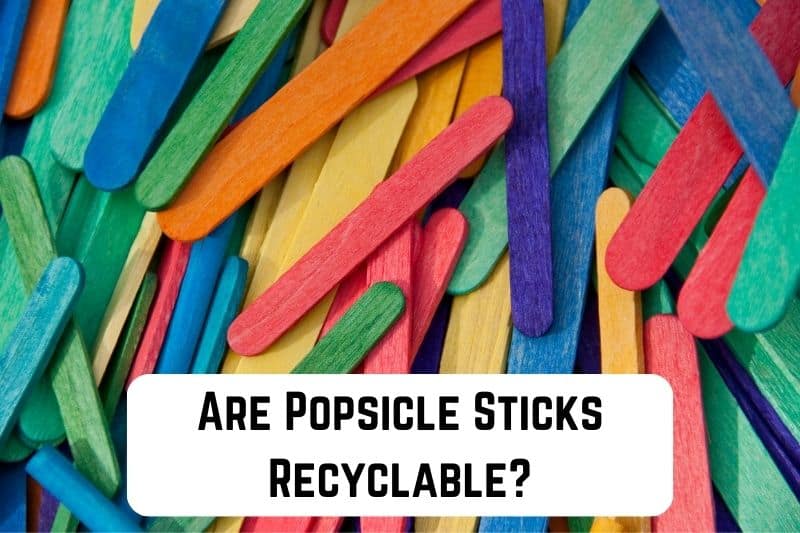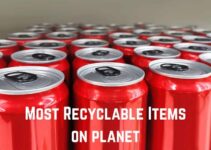It makes sense that you would be thinking about popsicles now that summer is well and truly here. Popsicle sticks are short, thin sticks made of wood or plastic used to store frozen delicacies or as a craft material. They are sometimes referred to as ice cream sticks or art sticks.
However, they bring a waste management concern: what will you do with the popsicle sticks? Can you recycle popsicle sticks? Is it possible to compost them? We will discuss all these questions in detail as we move on.
Can You Recycle Popsicle Sticks?
Popsicle sticks cannot be recycled because recycling facilities require larger sticks to sort and process them. Since popsicle sticks are typically composed of plastic and wood, recycling them takes time and effort.
Recycling popsicle sticks is more difficult because they are frequently tainted with grease or other materials. When popsicle sticks are no longer needed, they must be thrown in the trash. Wood, which may be recycled in various ways, is frequently used to make popsicle sticks.
However, the sticks might or might not be appropriate for recycling based on the sort of wood applied and the treatment it has received. It is easiest to find out if popsicle sticks are accepted for recycling by contacting your neighborhood recycling facility. If you have the space, you can even compost the sticks in your backyard.
Most localities have laws that forbid or restrict recycling of popsicle sticks. On the other hand, you’ll find an Italian company called Kibelis. The company has offered cute box designs to pubs in Italy. These sticks were eventually cut, cleaned, painted, and utilized to create a collection of talking clocks as the outcome of its efforts.
Make one out of popsicle sticks if you like geometric designs. Cut the components into the desired shape for your earrings using paper. Giving them a full day without any attention is advisable before decorating them how you choose. Popsicle sticks make a great recycling material as they’re biodegradable and environmentally beneficial.
Popsicle sticks are biodegradable and versatile, so there are plenty of chances for creative recycling and reuse, even when standard recycling may not be their main use. These insignificant sticks have the potential to favorably impact sustainability initiatives and encourage resourcefulness in waste reduction by embracing innovation and investigating alternative recycling options.
Are Popsicle Sticks Biodegradable?
In general, popsicle sticks are biodegradable. They are usually constructed from organic, natural materials, mostly birch wood. Because birch wood is biodegradable, it will naturally break down due to environmental factors.
However, environmental factors like temperature, moisture, and microbial growth in the compost or soil affect how long Popsicle sticks are required to biodegrade. Compared to synthetic materials, wood-based items like Popsicle sticks decompose quickly under the right circumstances.
Popsicle sticks are naturally environmentally beneficial since they are made of wood pulp, which is manufactured from renewable materials like trees, especially birch trees. Known for its durability and smooth texture, birch wood is manufactured into the little, flat sticks that are so familiar to us.
Because of their natural nature, Popsicle sticks can be sustainable for the environment when disposed of properly. These sticks biodegrade naturally after being thrown away, returning to the soil. Biodegradation starts when an organism is exposed to moisture, microorganisms, and oxygen in a favorable environment, such as compost piles or soil with the right circumstances.
The sticks decompose with time, reverting to organic matter and enriching the soil without leaving any toxic residues behind. You may compost or put Popsicle sticks in organic trash bins if you seek an environmentally friendly way to eliminate them.
They won’t affect the environment over time if disposed of in compost or soil; instead, they will ultimately break down and return to their natural state. Always verify the local waste disposal regulations to ensure the right disposal techniques are being used in your community.

Are Popsicle Sticks Compostable?
Wooden popsicle sticks can be composted, but it’s vital to remember that you should proceed carefully. Breaking them up into little pieces is advisable to guarantee they will decompose rapidly in the compost.
It’s also crucial to remember that any plastic or chemical finishes on these sticks should be removed because they won’t decompose and might contaminate the compost. Lastly, since wood popsicle sticks degrade slowly and require much time and work, they should only be added sparingly.
Wooden popsicle sticks can make the perfect addition to the compost pile if you treat them properly. Wooden popsicle sticks can decompose in composting environments, adding to the biological material and finally becoming compost. Popsicle sticks can be disposed of by stacking them in compost bins.
However, it’s crucial to ensure the composting environment is suitable for products made of wood. To promote decomposition, sufficient oxygen, moisture, and microbial activity are necessary for composting. Popsicle sticks can decompose and blend with the compost in the proper composting setting, adding organic matter to the soil.
Twigs and sticks can be easily recycled while also benefiting the environment by being composted. Sticks and twigs are woody materials that can be composted, even if it can take a while to break down.
If you put up a compost container for organic waste at home or contact your local recycling coordinator, you can compost Popsicle sticks. Composting is a useful recycling method, but certain items are meant to be kept from being composted.
How To Reuse Popsicle Sticks?
Popsicle and ice cream sticks are compostable and biodegradable as they are composed of wood. The simplest and greenest method of getting rid of them is composting them. They often take a year to decay because they are little completely.
Before reusing used Popsicle sticks, always wash and disinfect them, particularly if they have come into contact with food or liquids. Popsicle sticks are an eco-friendly, adaptable, and handy material for do-it-yourself projects. They can be turned into various colorful and functional objects with a little imagination.
There are a few ways you can reuse your popsicle sticks before you have to compost them. Among them are:
Make DIY Bracelets
You can twist popsicle sticks to create adorable bracelets, and it’s not difficult. You must boil them gently for an hour before doing anything else. Next, while they remain warm and wet, take each one out of the water one at a time, shape them into a circle, and put them in aerosol cans. After giving them a day to rest, decorate them however you choose.
Make Earrings
It’s interesting to note that you can make some amazing earrings by breaking up popsicle sticks into smaller sections and sticking them in different shapes. If you’d like, you can even add some glitter.
Make a Shelf
We have good news for fans of geometric shelves: popsicle sticks can be used to create one. About a hundred of these sticks, some adhesive, paint, and a shape template are all you’ll need.
Create a Photo Frame
Popsicle sticks can be glued together to create miniature photo frames in square or rectangular shapes. Use paint, glistening glitter, or other creative supplies to adorn them.
Create a Tiny Chalkboard Door Hanger
Popsicles may be used to create a rather sturdy door hanger with adhesive, ribbons, blackboard paint, chalk, and ornaments. You can even involve your child in the creative process.
Creating Coaster
In an emergency, you can create your coasters by joining popsicle sticks, staining them, and customizing them to your liking. The better they are, the more intimate.
Wall Art or Sunburst Mirror
Popsicle sticks can be arranged into geometric shapes or designs to create artwork or decorative decorations. To add some flair, paint or stain them. For a homemade mirror decoration, wrap some Popsicle sticks all around a tiny mirror to create the appearance of a sunburst.

Alternatives To Popsicle Sticks
When choosing substitutes for Popsicle sticks, consider the intended application and whether the product has to be heat-resistant, biodegradable, or suitable for culinary applications.
Wooden Chopsticks
Wooden chopsticks are commonly found at numerous eateries and grocery stores and can be reused as popsicle sticks.
Silicone Molds
No additional stick is needed when shaping frozen food into entertaining forms with silicone molds.
Bamboo Skewers
Popsicle sticks can be replaced with natural, biodegradable bamboo skewers. They may be used for crafts or the same uses as popsicle sticks, like holding frozen goodies.
Dowels
Wooden dowels are adaptable for various tasks because they are available in multiple lengths and diameters. Although they can be cut into tiny bits for handicrafts, they are frequently utilized in woodworking.
Wooden Coffee Stirrers
These sticks, which resemble Popsicle sticks in size and form, are frequently used for stirring coffee, but they may additionally be utilized for small-scale building projects or crafts.
Conclusion
Popsicle sticks’ small size and mixture of components make them generally non-recyclable. Popsicle sticks frequently need to be larger to be sorted and cleaned by recycling facilities, even though recycling is vital to preserve natural resources and minimize waste.
Furthermore, popsicle sticks are challenging to recycle because they are typically composed of plastic and wood. Reusing and recycling these sticks is an easy yet powerful approach to improving the environment and changing the world.






